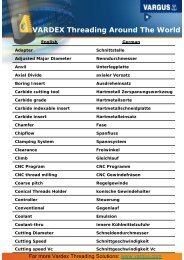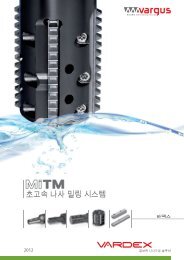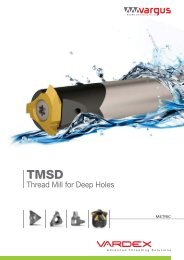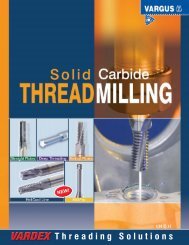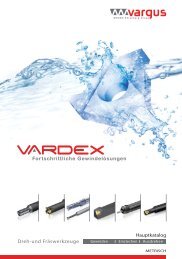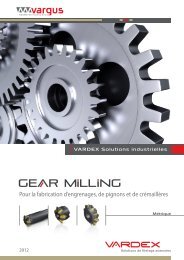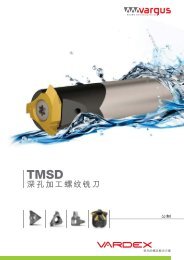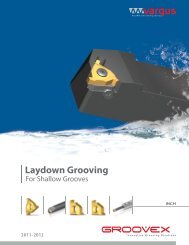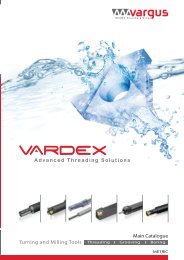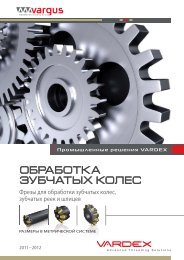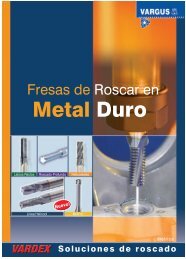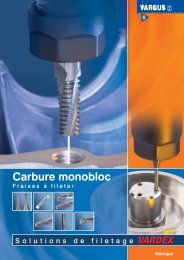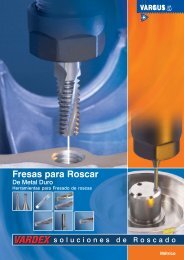- Page 1 and 2:
Turning and Milling Catalog Thread
- Page 3 and 4:
VARGUS Number one in threading VARG
- Page 5 and 6:
TURNING Thread Turning System - Ext
- Page 7 and 8:
Thread Turning System - External St
- Page 9 and 10:
Tooling recommendation for a given
- Page 11 and 12:
Tooling recommendation for a given
- Page 13 and 14:
Tooling recommendation for a given
- Page 15 and 16:
Tooling recommendation for a given
- Page 17 and 18:
Tooling recommendation for a given
- Page 19 and 20:
Threading Inserts THREAD TURNING IN
- Page 21 and 22:
Y Threading Inserts Partial Profile
- Page 23 and 24:
Threading Inserts Partial Profile 6
- Page 25 and 26:
Threading Inserts Partial Profile 5
- Page 27 and 28:
Y Threading Inserts American UN Ext
- Page 29 and 30:
Threading Inserts American UN (con
- Page 31 and 32:
Y Y Threading Inserts American UN (
- Page 33 and 34:
Y Threading Inserts American UNC (c
- Page 35 and 36:
Threading Inserts American UN (con
- Page 37 and 38:
Y Y Threading Inserts ISO Metric Ex
- Page 39 and 40:
Threading Inserts ISO Metric (con
- Page 41 and 42:
Y Y Threading Inserts ISO Metric (c
- Page 43 and 44:
Y Threading Inserts ISO Metric (con
- Page 45 and 46:
Threading Inserts ISO Metric (con
- Page 47 and 48:
Y Y Threading Inserts UNJ (con’t)
- Page 49 and 50:
Y Y Threading Inserts UNJ (con’t)
- Page 51 and 52:
Y Y Threading Inserts NPT External
- Page 53 and 54:
Y Y Y Threading Inserts NPT (con’
- Page 55 and 56:
Y Y Y Threading Inserts NPTF Extern
- Page 57 and 58:
Threading Inserts NPTF (con’t) In
- Page 59 and 60:
Y X X X Y T Threading Inserts Ameri
- Page 61 and 62:
Threading Inserts American ACME (co
- Page 63 and 64:
Y Y X Threading Inserts Stub ACME (
- Page 65 and 66:
Y Y Threading Inserts American Butt
- Page 67 and 68:
Y Threading Inserts Whitworth for B
- Page 69 and 70:
Y Threading Inserts Whitworth for B
- Page 71 and 72:
Y Y Threading Inserts Whitworth for
- Page 73 and 74:
Threading Inserts Whitworth for BSW
- Page 75 and 76:
Y Y Threading Inserts BSPT (con’t
- Page 77 and 78:
Y X X X Y T Threading Inserts Trape
- Page 79 and 80:
Y X Threading Inserts Trapez (DIN 1
- Page 81 and 82:
X Y Threading Inserts Round (DIN 20
- Page 83 and 84:
X Y Y Threading Inserts API Buttres
- Page 85 and 86:
Y Y Y Threading Inserts API Round C
- Page 87 and 88:
Y X Threading Inserts EL-Extreme Li
- Page 89 and 90:
Y Y Threading Inserts MJ (ISO 5855)
- Page 91 and 92:
Y X Threading Inserts Metric Buttre
- Page 93 and 94:
Y Threading Inserts Pg (DIN 40430)
- Page 95 and 96:
TURNING TOOLHOLDERS Contents Thread
- Page 97 and 98:
External Toolholders 2° Thread Tur
- Page 99 and 100:
External Toolholders 2° Thread Tur
- Page 101 and 102:
External Toolholders Thread Turning
- Page 103 and 104:
External Toolholders Thread Turning
- Page 105 and 106:
Internal Toolholders Thread Turning
- Page 107 and 108:
Internal Toolholders Thread Turning
- Page 109 and 110:
Internal Toolholders Thread Turning
- Page 111 and 112:
Internal Toolholders Thread Turning
- Page 113 and 114:
Internal Toolholders Thread Turning
- Page 115 and 116:
Internal Toolholders Thread Turning
- Page 117 and 118:
Thread Turning Toolholders 116
- Page 119 and 120:
THREAD TURNING TECHNICAL DATA Conte
- Page 121 and 122:
Machining a Multi-Start Thread A th
- Page 123 and 124:
Calculating the Helix Angle and Cho
- Page 125 and 126:
Anvils Threading Technical Data Res
- Page 127 and 128:
Recommended Grades and Cutting Spee
- Page 129 and 130:
Number of Passes Pitch mm 0.50 0.75
- Page 131 and 132:
Radial infeed per pass Threading Te
- Page 133 and 134:
Radial infeed per pass Threading Te
- Page 135 and 136:
Radial infeed per pass Threading Te
- Page 137 and 138:
Number of Passes and Depth of Cut p
- Page 139 and 140:
5 Choose the Correct Anvil Anvil ch
- Page 141 and 142:
5 6 Choose the Correct Anvil (see p
- Page 143 and 144:
Threading Technical Data 142
- Page 145 and 146:
GROOVING INSERTS Contents Grooving
- Page 147 and 148:
I C I C DIN 471 Retaining Ring Groo
- Page 149 and 150:
Grooving Inserts 148 m L2 L t B F W
- Page 151 and 152:
I C CIRCLIP Inch Standard External
- Page 153 and 154:
Grooving Inserts 152 L2 L t B F W L
- Page 155 and 156:
Grooving Inserts 154 R L t B F W L1
- Page 157 and 158:
IC IC DIN 76 Thread Undercuts (For
- Page 159 and 160:
Circlip - Face Grooves Internal W F
- Page 161 and 162:
GROOVING TOOLHOLDERS Contents Exter
- Page 163 and 164:
Internal Toolholders d Double Ended
- Page 165 and 166:
Internal Toolholders D D1 A L1 L Mi
- Page 167 and 168:
Grooving Technical Data Recommended
- Page 169 and 170:
BORING INSERTS VARDEX Ordering Code
- Page 171 and 172:
Internal IC T R 7° WC0W inserts fo
- Page 173 and 174:
Micro Tooling Internal F 25° R S L
- Page 175 and 176:
Micro Tooling Internal L R0.2 F W d
- Page 177 and 178:
BORING TOOLHOLDERS ÃVARDEX Orderin
- Page 179 and 180:
Series B - Boring Bars D1 A* Alloy
- Page 181 and 182:
Series F - Boring Bars D1 A Alloy S
- Page 183 and 184:
Internal Toolholders (con’t) Sing
- Page 185 and 186:
BORING TECHNICAL DATA Spare Parts P
- Page 187 and 188:
Boring Technical Data 186
- Page 189 and 190:
TM Inserts MILLING The Right Tool f
- Page 191 and 192:
TM Inserts Thread Milling Methods E
- Page 193 and 194:
TM Inserts Tooling recommendation*
- Page 195 and 196:
TM Inserts Tooling recommendation*
- Page 197 and 198:
TM Inserts Tooling recommendation*
- Page 199 and 200:
TM Inserts Tooling recommendation*
- Page 201 and 202:
TM Inserts Tooling recommendation*
- Page 203 and 204: TM Inserts THREAD MILLING INSERTS V
- Page 205 and 206: TM Inserts American UN (Con’t) Ex
- Page 207 and 208: TM Inserts American UN (Con’t) In
- Page 209 and 210: TM Inserts American UN (Con’t) Ex
- Page 211 and 212: TM Inserts UNJ External / Internal
- Page 213 and 214: TM Inserts ISO Metric (Con’t) Ext
- Page 215 and 216: TM Inserts ISO Metric (Con’t) Ext
- Page 217 and 218: TM Inserts NPT External / Internal
- Page 219 and 220: TM Inserts NPS External / Internal
- Page 221 and 222: TM Inserts W for BSW only (Con’t)
- Page 223 and 224: TM Inserts W for BSW, BSP (Con’t)
- Page 225 and 226: TM Inserts ACME Internal L Le 29°
- Page 227 and 228: TM Inserts 226
- Page 229 and 230: MILLING TOOLHOLDERS Contents TM Hol
- Page 231 and 232: External and Internal Toolholders L
- Page 233 and 234: External and Internal Toolholders L
- Page 235 and 236: External and Internal Toolholders L
- Page 237 and 238: Spare Parts For VARDEX TM and TMSH
- Page 239 and 240: THREAD MILLING SOLID CARBIDE Conten
- Page 241 and 242: ISO Metric Internal 1/4P Internal 6
- Page 243 and 244: Whitworth External / Internal R0.13
- Page 245 and 246: American UN 1/4P Internal 60° Le D
- Page 247 and 248: NPT External / Internal 30° 30° I
- Page 249 and 250: BSPT External / Internal R0.137P 27
- Page 251 and 252: 250
- Page 253: THREAD MILLING TECHNICAL DATA About
- Page 257 and 258: Appendix C List of “G” Codes (I
- Page 259 and 260: Recommended Grades, Cutting Speeds
- Page 261 and 262: Minimum Bore Diameters for Thread M
- Page 263 and 264: GROOVE MILLING INSERTS VARDEX Order
- Page 265 and 266: Circlip DIN 471/472 External / Inte
- Page 267 and 268: Grooving Inserts 266
- Page 269 and 270: Toolholders D2 tmax. L L1 d D1 Mult
- Page 271 and 272: Grooving Holders 270
- Page 273 and 274: Recommended Grades, Cutting Speeds
- Page 275: www.vargustooling.com Call us - tol



